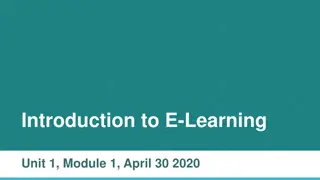Regional Development Disparities in Kenya, India, and Other Countries
The provided content discusses the disparities in development indicators across different regions, focusing on Kenya, India, and other countries. It highlights significant differences in education, wealth, and health outcomes, showcasing how certain regions are more developed than others based on specific metrics. The analysis underscores the various challenges and variations in development levels, emphasizing the need for targeted interventions to address disparities.
Download Presentation

Please find below an Image/Link to download the presentation.
The content on the website is provided AS IS for your information and personal use only. It may not be sold, licensed, or shared on other websites without obtaining consent from the author. Download presentation by click this link. If you encounter any issues during the download, it is possible that the publisher has removed the file from their server.
E N D
Presentation Transcript
(i) comparative statements. Maximum of 4 marks for specific data taken from the resources. Award up to 2 marks for interpretation/explanation of indicators ie how they show development. Candidates should be able to identify several differences between provinces using the figures provided. It is clear that the North Eastern province is by far the least developed across the development indicators and that Central province is clearly at the highest level of development within Kenya. Candidates should get credit for noting that the table covers the three major areas of education, wealth and health and could comment on each of these in turn. Assess out of 10 giving credit to answers which make good use of statistics to illustrate Education varies from 87% of females with no education in North Eastern province to only 10% in Nairobi. The striking difference between male and female percentages, especially in poorer provinces, with males getting preferential treatment in many developing countries, could be noted. Wealth all areas of Kenya have many poor, but again big variation from almost 2/3 in North Eastern, Western and Nyanza to <1/3 in Central. Health huge variation again here with >3/4 of children in Central province having all vaccinations whereas only 8% in North Eastern are protected. The North Eastern province trails all others alarmingly in this indicator. 10 marks
explain 4
Assess out of 8, giving credit to answers which make good use of statistics to illustrate comparative statements. Award marks for interpretation/explanation of indicators ie how they show development. Award maximum of 3 marks for comparative data taken from the table. Candidates should be able to identify several differences between the regions of India using the data in the table. It is clear from looking at all these development indicators that Southern India is the most developed region (1 mark), with Eastern India and The Plains vying for the least developed regions (1 mark). For % Literacy Rate, it could be noted that only 9% separates all the regions so there is not a great difference between them all. However, South India has the highest literacy rate at 83%, whereas Eastern India has the lowest at 74%. For Infant Mortality Rate, it could be noted that South India has the lowest (best) figures at 29, whereas The Plains has the highest (worst) infant mortality at 47 (a difference of 18 live births per 1000). For Birth Rate, it could be noted that South India has the lowest at 16, whereas The Plains has the highest birth rate at 23. For % households using electricity for lighting, South India is again the best with 94%, whereas Eastern India has only 62% (a difference of 32%). 8
2015 Higher Paper GDP per person shows that Brazil, Mexico and Cuba are emergent developing countries with an intermediate level of income, while Kenya and Malawi are still classed as low income developing countries (1 mark). Employment in agriculture is far higher in Malawi (90%) than Brazil at 16% so it is less industrialised (1 mark). Adult literacy is far higher in Brazil, Mexico and Cuba than in Malawi suggesting they have more schools (1 mark). Birth rate shows a vast difference in development with both African countries having high birth rates (Kenya 30%); compared with Mexico at 18%, suggesting lack of contraception/education (1 mark). There is also a large difference between the country with the poorest life - Malawi has a life expectancy of 53 whereas Cuba is 78, suggesting better health care. (1 mark).
However this shows averages which can hide extremes within a country such as a rich minority and a poor majority (1 mark). Development is not only about money, other aspects of development like literacy and healthcare are also important (1 mark). Composite indicators such as HDI give a more rounded picture; by combining a number of indicators (1 mark). It is not possible to tell where a rise in GNI is being spent within a country - not always spent on improving standard of living (1 mark). GNI is always expressed as Dollars to allow comparison, however exchange rates continually fluctuate (1 mark). GNI does not take into account the informal economy however this accounts for a large proportion of wealth generated in some countries (1 mark).
GDP per person shows that Brazil, Mexico and Cuba are emergent developing countries with an intermediate level of income, while Kenya and Malawi are still classed as low income developing countries (1 mark). Employment in agriculture is far higher in Malawi (90%) than Brazil at 16% so it is less industrialised (1 mark). Adult literacy is far higher in Brazil, Mexico and Cuba than in Malawi suggesting they have more schools (1 mark). Birth rate shows a vast difference in development with both African countries having high birth rates (Kenya 30%); compared with Mexico at 18%, suggesting lack of contraception/education (1 mark). There is also a large difference between the country with the poorest life - Malawi has a life expectancy of 53 whereas Cuba is 78, suggesting better health care. (1 mark).
Oral Rehydration Therapy is the mixture of salt and sugar with clean water to help people suffering from diarrhoea (1 mark); it is very effective as it is cheap and simple and it can be administered by untrained staff (1 mark). Vaccination programmes such as the UNICEF run polio immunisation campaign were delivered to rural areas as people here find it more difficult to access healthcare (1 mark). By 2014 polio was endemic in only 3 countries (Afghanistan, Pakistan and Nigeria) (1 mark). Charities such as Water Aid work with countries and other aid agencies to improve water and sanitation by installing eg pit latrines (1 mark). By 2010 the number of people without access to improved drinking water had decreased to (11%) and the ash compost from latrines can improve crop yield (1 mark). Barefoot Doctors provide health education through play and songs as many people are illiterate in developing countries (1 mark). Insecticide treated bed nets provide a physical barrier against the mosquito and kills the mosquito preventing further spread (1 mark). However, they need to be treated regularly to be effective and in some cases are used as fishing nets (1 mark). Play Pumps International provide roundabouts which extract ground water which can be used for drinking (1 mark) these provide local people with transferable skills and use appropriate level of technology (1 mark).
Some countries have natural resources such as oil, which can be sold to generate foreign currency (1 mark). Some countries e.g. Chad are landlocked, are find it more expensive to export and import goods. (1 mark). Countries with a poor education system have many low skilled workers and are unable to attract foreign investment (1 mark). Countries with fertile soils and a suitable climate can grow cash crops which can be sold for income (1 mark). Corruption in government such as in Nigeria can lead to money being used inappropriately (1 mark). Where countries suffer from conflict or civil war they are unable to keep the economy working and spend extra finance on weapons (1 mark). Countries which have accumulated large debts have to repay loans and interest causing less money for services (1 mark). Famine can lead to malnutrition, and a reduced capacity to work and create income (1 mark).
Some countries have natural resources such as oil, which can be sold to generate foreign currency (1 mark). Some countries e.g. Chad are landlocked, are find it more expensive to export and import goods. (1 mark). Countries with a poor education system have many low skilled workers and are unable to attract foreign investment (1 mark). Countries with fertile soils and a suitable climate can grow cash crops which can be sold for income (1 mark). Corruption in government such as in Nigeria can lead to money being used inappropriately (1 mark). Where countries suffer from conflict or civil war they are unable to keep the economy working and spend extra finance on weapons (1 mark). Countries which have accumulated large debts have to repay loans and interest causing less money for services (1 mark). Famine can lead to malnutrition, and a reduced capacity to work and create income (1 mark).
4 6 3
Measures taken to treat those suffering from Malaria include: Drugs such as Quinine/Chloroquine/Larium/Malarone/Artemisia were all developed in an attempt to kill the parasite or prevent infection. (1 mark) Trials have produced a vaccine (RTS,S) which has now been recommended as being safe for use, as prevention is better than cure. (1 mark) Measures taken to prevent people being bitten by the mosquito: Education programmes such as the WHO s Roll Back Malaria campaign. In particular educating people in the use of Insect repellents. (1 mark) Covering the skin at dawn/dusk when mosquitoes are most active to reduce the chances of being bitten. (1 mark) The increased use of insecticide-coated mosquito nets at night was an attempt to stop the mosquitoes from biting people and passing on the disease as people slept. (1 mark) Possible comments on the effectiveness might include: Insecticides to kill the mosquito were effective at first however the mosquito became resistant to DDT and alternative insecticides are often too expensive for developing countries. (1 mark) Mosquito traps have been effective at a small scale, but mosquitoes breed so quickly that it is impossible to trap them all. (1 mark) The BTI bacteria in coconuts is a cheap and environmentally friendly solution, with 2/3 coconuts clearing a typical pond of mosquito larvae for 45 days. (1 mark) Draining stagnant ponds is impossible to be effective on a large-scale, especially in tropical climates where it can rain heavily most days. (1 mark) Using mosquito nets at night/covering up exposed skin is effective as mosquitoes are often most active during dusk and dawn. (1 mark) Drugs to kill the parasite once inside humans have been effective for a spell, but the parasite often adapts and becomes resistant this is true even of the Artemisia-based drugs in SE Asia. (1 mark) Anti-malarial drugs often have unpleasant side-effects so may prevent people from completing the whole course. (1 mark) They are also expensive to research, develop and produce, making them often too expensive for people living in developing countries. (1 mark) Scientists have trialled a vaccine on children across Africa and the early results from this are encouraging (a 56% drop in malaria after a year with children who had the vaccine, compared with those who did not). (1 mark) Putting larvae-eating fish such as the muddy loach into ponds. As the fish breed, this has the added advantage for farmers who can eat some of the fish and add extra protein to their diet. (1 mark)























